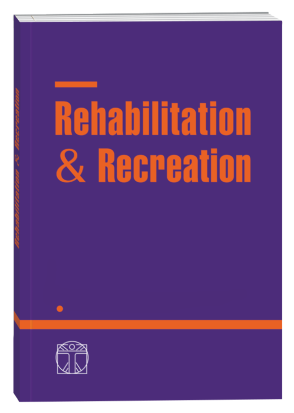EFFECTIVENESS OF CORRECTION OF POSTPARTUM LUMBOPELVIC PAIN IN WOMEN WITH PELVIC FLOOR DYSFUNCTION AFTER VARIOUS METHODS OF DELIVERY USING PHYSICAL THERAPY
DOI:
https://doi.org/10.32782/2522-1795.2025.19.2.1Keywords:
physical therapy, rehabilitation, women, postpartum period, obstetrics and gynecology, cesarean section, childbirth, pelvic floor dysfunctionAbstract
Aim – to evaluate the effectiveness of the developed comprehensive physical therapy program for women with pelvic floor dysfunction after vaginal and abdominal delivery according to indicators associated with lumbopelvic pain. Material. 175 women participated in the study. The control group consisted of 32 women who had no history of pregnancies and were not characterized by diagnosed pelvic floor dysfunction. The group with signs of pelvic floor dysfunction in the postpartum period consisted of 143 women who were divided into two groups (comparison – gave birth vaginally and main – gave birth abdominally) with two subgroups in each. Subgroup 1 was restored according to the recommendations of clinical protocols, subgroup 2 – according to the developed physical therapy program lasting 3 months with the use of therapeutic exercises (for the lower extremities, pelvic girdle, trunk, with a wireless Kegel trainer), preformed physical factors (pelvic floor muscle stimulator), educational component. The effectiveness was assessed by the results of the visual analogue pain scale, Oswestry Disability Index, Pelvic Girdle Questionnaire, Pregnancy Mobility Index, Ott, Schober, Thomayer, Sedin tests, and the deadlift index. Results. Women with pelvic floor dysfunction after childbirth, regardless of abdominal or vaginal delivery, remain at high risk of new and prolongation of existing signs of lumbopelvic pain. Lumbopelvic pain in them in the late postpartum period is associated with moderate pain (according to the visual analog scale), limitations in vital activity (according to the Oswestry Disability Index, Pelvic Girdle Questionnaire, Pregnancy Mobility Index), deterioration of spinal mobility even in the absence of pain syndrome (determined by the Ott, Schober, Thomayer, Sedin tests), decreased back muscle strength (according to the deadlift index). The use of a physical therapy program with the use of specific methods of influence aimed at leveling pelvic floor dysfunction in combination with a set of therapeutic exercises for the trunk and extremities allowed a statistically significant (p<0.05) improvement in the results of the visual analogue scale, Oswestry Disability Index, Pelvic Girdle Questionnaire, Pregnancy Mobility Index, and deadlift index over three months in comparison with the baseline parameters and the corresponding indicators of women who recovered independently. The magnitude of the absolute achieved effect of the physical therapy program depended on the initial parameters associated with the type of childbirth – abdominal or vaginal, but was proportionally the same for both methods of childbirth. Conclusions. Physical therapy is advisable to prescribe to reduce the intensity of symptoms of lumbopelvic pain and prevent the chronicity of pain syndrome in women with postpartum pelvic floor dysfunction, which threatens with psychoneurological disorders, loss of work capacity, and decreased quality of life, i.e. for faster postpartum recovery of women and their return to full-fledged life activities.
References
1. Aravitska M.H., Saienko O.V. The influence of physical therapy on indicators of locomotive syndrome in elderly persons with osteoarthritis of the knee and obesity. Clinical and Preventive Medicine. 2023. № 4(26). Р. 6–13. https://doi.org/10.31612/2616-4868.4(26).2023.01.
2. Arnouk A., De E., Rehfuss A., Cappadocia C., Dickson S., Lian F. Physical, Complementary, and Alternative Medicine in the Treatment of Pelvic Floor Disorders. Curr Urol Rep. 2017. № 18(6). Р. 47. doi: 10.1007/s11934-017-0694-7.
3. Del Forno S., Cocchi L., Arena A., et al. Effects of Pelvic Floor Muscle Physiotherapy on Urinary, Bowel, and Sexual Functions in Women with Deep Infiltrating Endometriosis: A Randomized Controlled Trial. Medicina (Kaunas). 2023. № 60(1). Р. 67. doi: 10.3390/medicina60010067.
4. Dufour S., Vandyken B., Forget M.J., Vandyken C. Association between lumbopelvic pain and pelvic floor dysfunction in women: A cross sectional study. Musculoskelet Sci Pract. 2018. № 34. Р. 47–53. doi: 10.1016/j.msksp.2017.12.001.
5. Ehsani F., Sahebi N., Shanbehzadeh S., Arab A.M., ShahAli S. Stabilization exercise affects function of transverse abdominis and pelvic floor muscles in women with postpartum lumbo-pelvic pain: a doubleblinded randomized clinical trial study. Int Urogynecol J. 2020. № 31(1). Р. 197–204. doi: 10.1007/s00192-019-03877-1.
6. Fairbank J.C., Pynsent P.B. The Oswestry Disability Index. Spine (Phila Pa 1976). 2000. № 15; 25(22). Р. 2940–2952. doi: 10.1097/00007632-200011150-00017.
7. Huang Q., Tang J., Zeng D., Zhang Y., Ying T. The effect of postpartum nursing guidance on early pelvic floor dysfunction recovery in women of advanced maternal age: a randomized controlled trial. Front Med (Lausanne). 2024. № 11. Р. 1397258. doi: 10.3389/fmed.2024.1397258.
8. Kuravska Yu., Aravitska M., Churpiy I., Fedorivska L., Yaniv O. Efficacy of correction of pelvic floor muscle dysfunction using physical therapy in women who underwent Caesarean section. J Phys Educ Sport. 2022. № 22(3). Р. 715–723. doi: 10.7752/jpes.2022.03090.
9. Narayanan S.P., Bharucha A.E. A Practical Guide to Biofeedback Therapy for Pelvic Floor Disorders. Curr Gastroenterol Rep. 2019. № 21(5). Р. 21. doi: 10.1007/s11894-019-0688-3.
10. Rakaieva A.E., Aravitska M.G. Study of the effectiveness of rehabilitation intervention for the correction of symptoms of asteno-vegetative syndrome in elderly persons with the consequences of coronavirus infection. Rehabilitation and Recreation. 2024. 8(3). 41–50. https://doi.org/10.32782/2522-1795.2024.18.3.4.
11. Romero-Franco N., Molina-Mula J., Bosch-Donate E., Casado A. Therapeutic exercise to improve pelvic floor muscle function in a female sporting population: a systematic review and meta-analysis. Physiotherapy. 2021. № 113. Р. 44–52. doi: 10.1016/j.physio.2021.04.006.
12. Stuge B., Garratt A., Jenssen H., Grotle M. The Pelvic Girdle Questionnaire: A Condition-Specific Instrument for Assessing Activity Limitations and Symptoms in People with Pelvic Girdle Pain. Physical Therapy. 2011. № 91(7). Р. 1096–1108.
13. Stuge B., Hilde G., Vøllestad N. Physical therapy for pregnancy-related low back and pelvic pain: a systematic review. Acta Obstet Gynecol Scand. 2003. № 82(11). Р. 983–90. doi: 10.1034/j.1600-0412.2003.00125.x.
14. van de Pol G., de Leeuw J.R., van Brummen H.J., Bruinse H.W., Heintz A.P., van der Vaart C.H. The Pregnancy Mobility Index: a mobility scale during and after pregnancy. Acta Obstet Gynecol Scand. 2006. № 85(7) Р. 786–91. doi: 10.1080/00016340500456373.
15. Wang Y., Zhang S., Peng P., et al. The effect of myofascial therapy on postpartum rectus abdominis separation, low back and leg pain, pelvic floor dysfunction: A systematic review and meta-analysis. Medicine (Baltimore). 2023. № 102(44). Р. e35761. doi: 10.1097/MD.0000000000035761.
Downloads
Published
How to Cite
Issue
Section
License

This work is licensed under a Creative Commons Attribution-NonCommercial-NoDerivatives 4.0 International License.





